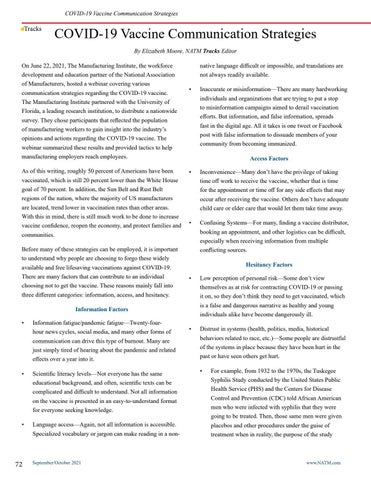COVID-19 Vaccine Communication Strategies
Tracks
COVID-19 Vaccine Communication Strategies By Elizabeth Moore, NATM Tracks Editor
On June 22, 2021, The Manufacturing Institute, the workforce development and education partner of the National Association of Manufacturers, hosted a webinar covering various communication strategies regarding the COVID-19 vaccine. The Manufacturing Institute partnered with the University of Florida, a leading research institution, to distribute a nationwide survey. They chose participants that reflected the population of manufacturing workers to gain insight into the industry’s opinions and actions regarding the COVID-19 vaccine. The webinar summarized these results and provided tactics to help manufacturing employers reach employees. As of this writing, roughly 50 percent of Americans have been vaccinated, which is still 20 percent lower than the White House goal of 70 percent. In addition, the Sun Belt and Rust Belt regions of the nation, where the majority of US manufacturers are located, trend lower in vaccination rates than other areas. With this in mind, there is still much work to be done to increase vaccine confidence, reopen the economy, and protect families and communities. Before many of these strategies can be employed, it is important to understand why people are choosing to forgo these widely available and free lifesaving vaccinations against COVID-19. There are many factors that can contribute to an individual choosing not to get the vaccine. These reasons mainly fall into three different categories: information, access, and hesitancy.
native language difficult or impossible, and translations are not always readily available. •
Access Factors •
Inconvenience—Many don’t have the privilege of taking time off work to receive the vaccine, whether that is time for the appointment or time off for any side effects that may occur after receiving the vaccine. Others don’t have adequate child care or elder care that would let them take time away.
•
Confusing Systems—For many, finding a vaccine distributor, booking an appointment, and other logistics can be difficult, especially when receiving information from multiple conflicting sources. Hesitancy Factors
•
Low perception of personal risk—Some don’t view themselves as at risk for contracting COVID-19 or passing it on, so they don’t think they need to get vaccinated, which is a false and dangerous narrative as healthy and young individuals alike have become dangerously ill.
•
Distrust in systems (health, politics, media, historical behaviors related to race, etc.)—Some people are distrustful of the systems in place because they have been hurt in the past or have seen others get hurt.
Information Factors •
Information fatigue/pandemic fatigue—Twenty-fourhour news cycles, social media, and many other forms of communication can drive this type of burnout. Many are just simply tired of hearing about the pandemic and related effects over a year into it.
•
Scientific literacy levels—Not everyone has the same educational background, and often, scientific texts can be complicated and difficult to understand. Not all information on the vaccine is presented in an easy-to-understand format for everyone seeking knowledge.
•
Language access—Again, not all information is accessible. Specialized vocabulary or jargon can make reading in a non-
72
September/October 2021
Inaccurate or misinformation—There are many hardworking individuals and organizations that are trying to put a stop to misinformation campaigns aimed to derail vaccination efforts. But information, and false information, spreads fast in the digital age. All it takes is one tweet or Facebook post with false information to dissuade members of your community from becoming immunized.
•
For example, from 1932 to the 1970s, the Tuskegee Syphilis Study conducted by the United States Public Health Service (PHS) and the Centers for Disease Control and Prevention (CDC) told African American men who were infected with syphilis that they were going to be treated. Then, those same men were given placebos and other procedures under the guise of treatment when in reality, the purpose of the study
www.NATM.com


































